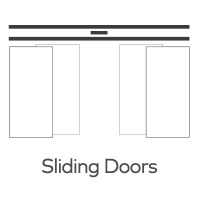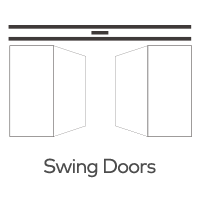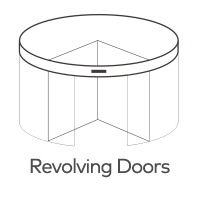Come reagisce un sensore laser a piccoli animali domestici o oggetti vicino a una porta oscillante?
Ospedali e laboratori sono ambienti in cui precisione, sicurezza e igiene sono fondamentali. Le porte oscillanti in queste impostazioni devono funzionare senza problemi per mantenere l'accessibilità, minimizzare i rischi di contaminazione e garantire la sicurezza del personale e delle attrezzature. I sensori laser vengono sempre più utilizzati per automatizzare e migliorare il funzionamento delle porte oscillanti in tali spazi critici. Ma i sensori laser sono adatti a queste applicazioni? Esploriamo le loro funzionalità e benefici in ambienti ospedalieri e di laboratorio.

Come funzionano i sensori laser sulle porte oscillanti? I sensori laser operano emettendo raggi laser per monitorare un'area designata per il movimento o la presenza. Quando il sensore rileva un oggetto o una persona nel suo campo, innesca la porta oscillante per aprirsi o fermarsi per evitare una collisione. La precisione e l'affidabilità della tecnologia laser la rendono particolarmente vantaggiosa in ambienti controllati come ospedali e laboratori. Vantaggi dell'uso di sensori laser in ospedali e laboratori
- Alta precisione e affidabilità
- I sensori laser offrono precisione puntuale, rilevando anche piccoli movimenti all'interno del loro raggio. Ciò garantisce che le porte rispondano rapidamente alla presenza di persone o attrezzature, riducendo i ritardi e migliorando il flusso di lavoro. Inoltre evitano attivazioni inutili causate da fattori ambientali come il flusso d'aria o cambiamenti di illuminazione, che sono cruciali in ambienti sensibili.
- Sicurezza migliorata
- In ospedali e laboratori, il movimento di pazienti, personale e attrezzature delicate richiede misure di sicurezza più elevate. I sensori laser possono distinguere tra oggetti stazionari e in movimento, assicurando che la porta non si chiuda su persone, sedie a rotelle o carrelli. Sono conformi agli standard di sicurezza come ANSI/BHMA per i sistemi di porte automatiche, rendendoli ideali per applicazioni sanitarie.
- Funzionamento igienico
- Attivazione senza tocco attraverso sensori laser riduce al minimo la necessità di contatto fisico, riducendo il rischio di contaminazione incrociata. Questo è particolarmente importante in aree come sale operatorie, sale pulite o sale di isolamento, dove una rigorosa igiene è fondamentale.
- Adattabilità all'alto traffico
- Ospedali e laboratori spesso sperimentano traffico a piedi elevato, incluso il movimento di barelle, carrelli e grandi gruppi di persone. I sensori laser possono gestire queste esigenze fornendo un funzionamento della porta coerente e reattivo.
- Versatilità ambientale
- I sensori laser funzionano bene in varie condizioni ambientali, incluse aree con fluttuazioni di temperatura, umidità o illuminazione intensa, che sono comuni in strutture sanitarie e di laboratorio.
Casi d'uso per sensori laser in ospedali e laboratori
- Sale operatorie e sale pulite
- I sensori laser garantiscono un funzionamento senza tocco e preciso della porta, mantenendo ambienti sterili. La loro capacità di definire zone di rilevamento specifiche impedisce false attivazioni da attività vicine.
- Camere di emergenza (ER)
- Nelle impostazioni di emergenza ad alta pressione, i sensori laser forniscono un'automazione rapida e affidabile delle porte, consentendo ai team medici di muoversi rapidamente con barelle o sedie a rotelle.
- Laboratori
- I laboratori ospitano spesso attrezzature e esperimenti sensibili che richiedono un accesso controllato. I sensori laser possono essere programmati per limitare il funzionamento della porta al personale autorizzato, migliorando la sicurezza.
- Strutture farmaceutiche
- Queste strutture beneficiano del funzionamento senza contaminazione delle porte attivate con laser, garantendo la conformità alle buone pratiche di fabbricazione (GMP).
- Camere di radiologia e imaging
- Le porte di queste camere devono funzionare in silenzio e senza vibrazioni per evitare di disturbare attrezzature sensibili. I sensori laser consentono movimenti fluidi e precisi della porta.
Considerazioni per l'implementazione di sensori laser in ospedali e laboratori
- Installazione e taratura
- Una corretta installazione e taratura sono essenziali per garantire che il campo di rilevamento del sensore sia ottimizzato per l'applicazione specifica. Le zone di rilevamento devono essere personalizzate per tenere conto del movimento di persone e attrezzature a diverse altezze.
- Manutenzione
- La pulizia e la manutenzione regolari dei componenti del sensore laser sono fondamentali in ambienti sterili per evitare che polvere o detriti interferiscano con le prestazioni del sensore.
- Conformità ai regolamenti
- I sensori laser utilizzati nell'assistenza sanitaria devono soddisfare gli standard di sicurezza e prestazioni, come l'ADA (Americans with Disabilities Act) e i codici edilizi locali.
- Integrazione con sistemi esistenti
- I sensori laser dovrebbero integrarsi senza problemi con altri sistemi di automazione, come i controlli HVAC o i sistemi di gestione degli accessi, per un'efficienza ottimale.
Sfide e limitazioni
- Costo: I sensori laser sono spesso più costosi dei tradizionali sensori a infrarossi o a microonde. Tuttavia, la loro affidabilità e precisione a lungo termine giustificano l'investimento in ambienti critici.
- Complessità: I sensori avanzati potrebbero richiedere una formazione specializzata per l'installazione e la risoluzione dei problemi.
Pensieri finali
- I sensori laser offrono precisione puntuale, rilevando anche piccoli movimenti all'interno del loro raggio. Ciò garantisce che le porte rispondano rapidamente alla presenza di persone o attrezzature, riducendo i ritardi e migliorando il flusso di lavoro. Inoltre evitano attivazioni inutili causate da fattori ambientali come il flusso d'aria o cambiamenti di illuminazione, che sono cruciali in ambienti sensibili.
- In ospedali e laboratori, il movimento di pazienti, personale e attrezzature delicate richiede misure di sicurezza più elevate. I sensori laser possono distinguere tra oggetti stazionari e in movimento, assicurando che la porta non si chiuda su persone, sedie a rotelle o carrelli. Sono conformi agli standard di sicurezza come ANSI/BHMA per i sistemi di porte automatiche, rendendoli ideali per applicazioni sanitarie.
- Attivazione senza tocco attraverso sensori laser riduce al minimo la necessità di contatto fisico, riducendo il rischio di contaminazione incrociata. Questo è particolarmente importante in aree come sale operatorie, sale pulite o sale di isolamento, dove una rigorosa igiene è fondamentale.
- Ospedali e laboratori spesso sperimentano traffico a piedi elevato, incluso il movimento di barelle, carrelli e grandi gruppi di persone. I sensori laser possono gestire queste esigenze fornendo un funzionamento della porta coerente e reattivo.
- I sensori laser funzionano bene in varie condizioni ambientali, incluse aree con fluttuazioni di temperatura, umidità o illuminazione intensa, che sono comuni in strutture sanitarie e di laboratorio.
- I sensori laser garantiscono un funzionamento senza tocco e preciso della porta, mantenendo ambienti sterili. La loro capacità di definire zone di rilevamento specifiche impedisce false attivazioni da attività vicine.
- Nelle impostazioni di emergenza ad alta pressione, i sensori laser forniscono un'automazione rapida e affidabile delle porte, consentendo ai team medici di muoversi rapidamente con barelle o sedie a rotelle.
- I laboratori ospitano spesso attrezzature e esperimenti sensibili che richiedono un accesso controllato. I sensori laser possono essere programmati per limitare il funzionamento della porta al personale autorizzato, migliorando la sicurezza.
- Queste strutture beneficiano del funzionamento senza contaminazione delle porte attivate con laser, garantendo la conformità alle buone pratiche di fabbricazione (GMP).
- Le porte di queste camere devono funzionare in silenzio e senza vibrazioni per evitare di disturbare attrezzature sensibili. I sensori laser consentono movimenti fluidi e precisi della porta.
- Una corretta installazione e taratura sono essenziali per garantire che il campo di rilevamento del sensore sia ottimizzato per l'applicazione specifica. Le zone di rilevamento devono essere personalizzate per tenere conto del movimento di persone e attrezzature a diverse altezze.
- La pulizia e la manutenzione regolari dei componenti del sensore laser sono fondamentali in ambienti sterili per evitare che polvere o detriti interferiscano con le prestazioni del sensore.
- I sensori laser utilizzati nell'assistenza sanitaria devono soddisfare gli standard di sicurezza e prestazioni, come l'ADA (Americans with Disabilities Act) e i codici edilizi locali.
- I sensori laser dovrebbero integrarsi senza problemi con altri sistemi di automazione, come i controlli HVAC o i sistemi di gestione degli accessi, per un'efficienza ottimale.







